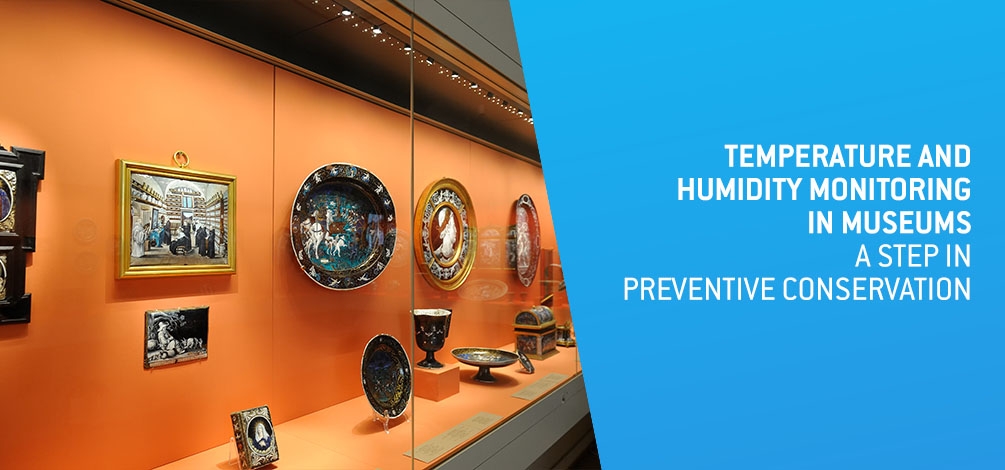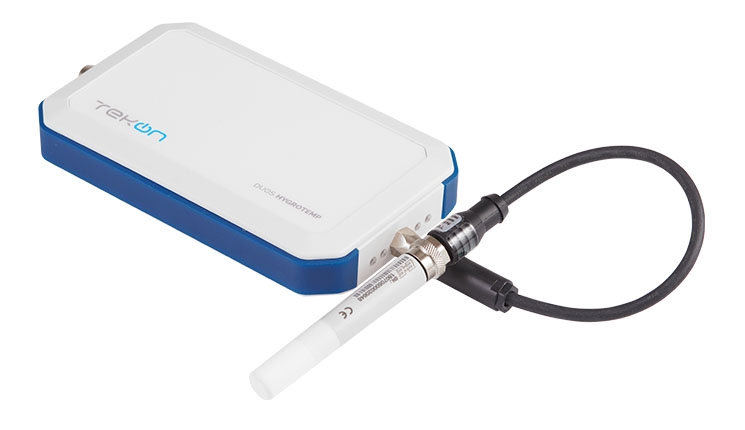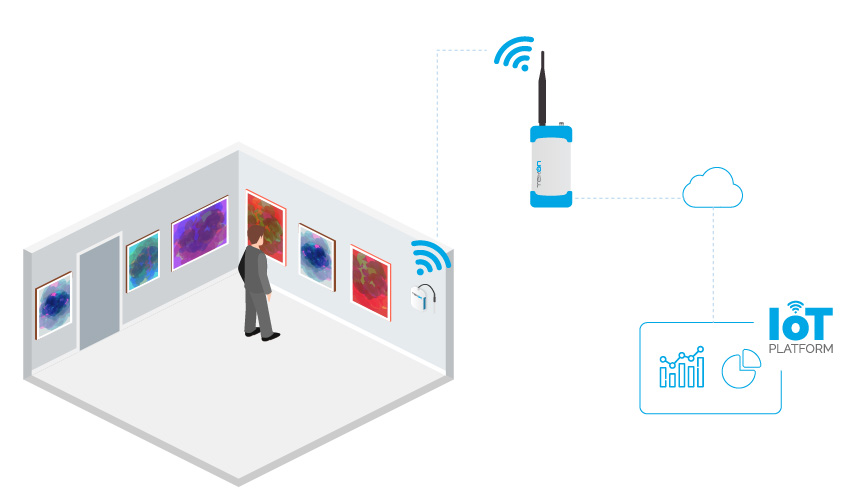TEMPERATURE AND HUMIDITY MONITORING IN MUSEUMS - A STEP IN PREVENTIVE CONSERVATION

Environmental conditions in museum spaces are largely responsible for promoting the acceleration of cultural assets deterioration. The preservation of collections is an ongoing concern for the directors and technicians of the institutions.
One way to keep present the history of the several cultures that preceded us is the dissemination and exposure of assets that lasted to the present times. The spaces with museum features have a dynamic that aims to attract the public to its environment. The conservation of artefacts is an expensive and time-consuming process and over time has been devoted to its planning to reduce the number of interventions, with an approach where preventive conservation has a reduced impact on dedicated resources and ensuring more efficiently the lifetime of objects. This new approach assigns greater relevance to the environmental conditions of exhibition and archiving of cultural goods, highlighting other determining variables in the present context.
Environmental conditions in museum spaces are largely responsible for promoting the acceleration of cultural assets deterioration. The preservation of collections is an ongoing concern for the directors and technicians of the institutions. Taking a precautionary behaviour related to the conservation of assets promotes their longevity as a demonstration piece and enables them to be available and in good condition remaining available for future generations.
Problems with lack of environmental monitoring
The material nature of cultural goods implies different rates of natural degradation. The notoriety of this process can be more severe by the absence of a metrologically controlled environment that can be influenced by several factors, catalogued into two types – external and internal.
The external factors refer to events that occur in the outside of the buildings and that may impact the interior environment. A good example of this facto is weather conditions, which can influence the temperature and relative humidity inside the building. The internal factors that interfere with the quality of environment include, for example, the type of lighting, heating/cooling equipment or the simple presence of visitor in the rooms. The inside environment is quite susceptible to variations from many sources.
Temperature
Temperature alone can cause several damages to the artefacts. Temperature increases are directly related to the increase in the rate of chemical reactions, leading to the degradation of goods made of material more prone to degradation when exposed to elevated temperatures. The exposure to improper temperatures cause lead to physical deformations such as expansion and contraction of materials. We refer to materials such as acetate and nitrate films, rubber, waxes, resins, acid paper, etc.
Relative humidity
Relative humidity is defined as the amount of water vapor present in a certain volume of air versus the maximum amount of water that the air can withstand at the current temperature. The edges of values of this variable may cause distinct reactions in collections. Relative humidity values above 70% increase the chance of the development of various types of organisms and microorganisms, corrosion to metals and crackling of glassware. With relative humidity values below 40%, organic materials can dry out and others can dry, shrink or even break.
Fluctuations
Numerous causes that can cause fluctuations in temperature and relative humidity values, lack of control can cause several damages to cultural assets, and monitoring helps to avoid or minimize their impact. Fluctuations in relative humidity and temperature can cause modifications and damages in objects that mostly translate into chemical reactions, dimensional variations and configuration changes that accelerate their deterioration.
Temperature and relative humidity in real time
Why monitor these variables in real time and have data accessible anytime anywhere? The opportunity to access this data in real time offers a generic and up-to-date view of the conditions of the museum space and thus understand its environment:
- Establish ideal temperature and relative humidity levels to verify if the spaces are in the right conditions for the exposed objects;
- Identify temperature and relative humidity fluctuations;
- Monitor the equipment to ensure it functions properly and confirm that it is properly calibrated;
- Understand how the indoor environment behaves in relation to outdoor weather over several times of the year;
- Develop and initiate appropriated actions to lower the risk of damage to items (exposed and reserved) when levels exceed ideal ranges;
- Deployment of solutions that make it possible to improve the interior environment;
- Perceive the response of control equipment regarding the presence or absence of visitors;
- Understand the correlation between environmental conditions at different times without the presence of visitors;
- Timely detect failures and degradation of operation of indoor weather control equipment.
The process of monitoring temperature and relative humidity in museum spaces adopts a modernization along with the emergence of new technological solutions that streamline the various procedures and bring the user to a new perspective about the space. Ensuring the recording of the mentioned variables in real time, intensifies the rate of attention paid to the safety of the environmental conditions surrounding the collections.
Process digitalization and information analysis focus on how imperative the immediate access to the data is being registered. Tekon Electronics is committed to the development of complete real time monitoring solutions focused on a variety of applications where temperature and relative humidity are primary order variables that affect the entire context.
DUOS HYGROTEMP + TEKON IoT PLATFORM
Tekon Electronics wireless solutions build up the answer to the need to monitor temperature and relative humidity with ease of integration into spaces where the digitalization of the surrounding environment will be of value. DUOS HYGROTEMP is a wireless transmitter with an external probe that allows the double recording of the values of temperature and relative humidity variables. Its portability and lack of connections that supply the necessary power to the device are an added benefit to the eventual need for redefinition and changes in the space layouts, as their operation is ensured by a high capacity recessed battery pack autonomy (*).
The equipment configuration also allows to set the time span between registers, providing suitable responsiveness for the spaces where monitoring may require tighter control. The installation of temperature and humidity sensors is one of the strengths of Tekon solution. Due to its dimensional features and the guaranteed battery life, there is no need to for any electrical wiring and no disturbances in the installation area.
Because it deploys a standalone wireless network without dependence or external costs, the solution is not a fixed operating cost and is therefore free of charge for temperature and humidity communications. This makes it possible to install the different temperature and humidity sensors within minutes without interference with local infrastructures.

Figure 1 - DUOS HYGROTEMP with temperature and relative humidity probe
Tekon IoT Platform allows data collected by the transmitter to be organized and viewed according to user preference. The relevance of real time monitoring and constant user connection is complemented by the possibility of setting alarms. The alarm system available enables the design of an environmental analysis model ensuring its constant vigilance and warning to the user whenever the registered values are different from those previously set as the ideal limit conditions. Tekon IoT Platform allows the configuration of different parameters that allow to understand and analyse the environment of the sites to monitor and foresee the necessary actions in order to ensure their compliance:
- Management of multiple and simultaneous transmitters;
- Different types of graphic charts for data visualization;
- Configuration of different alarms and warnings for variables;
- Definition of monitoring sensor communication failure alarms;
- Export data history for analysis;
- User management with access to the platform;

Figure 2 - Example of DUOS HYGROTEMP + TEKON IoT PLATFORM application
FINAL CONCLUSIONS
It is important to promote the good practices of preservation of several artefacts present in the many institutions. The environments in which they are exposed or archived have had a monitoring that has undergone several modifications and is now more modernized with the application of IoT technologies through devices and solutions oriented to this key concept.
Contact us at sales@tekonelectronics.com for more information about our solution or if you would like a quotation, please fill out our form.
(*) The estimated battery life of the supplied batteries is 3 years, considering a communication period of 10 minutes and a maximum transmission power at 25ºC. Batteries sold separately.